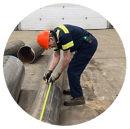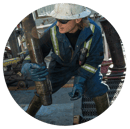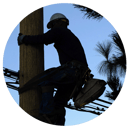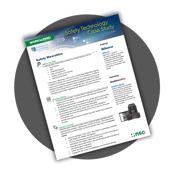Randy Gonzales is a Regional Sales Director for the Western US & Canada region of Blackline Safety. In this role, he helps drive revenue growth and market share within his area. With over 15 years of experience in various sales roles, Randy has developed a reputation for building relationships with customers and partners, delivering exceptional results, and leading high-performing teams. Before joining Blackline, Randy worked at leading technology and industrial companies such as Gas Clip Technologies, Airgas, Grainger. He’s passionate about helping customers achieve their business goals and is committed to delivering outstanding customer service and support.
Tackling "Big Brother" Monitoring Concerns
Randy Gonzales, Regional Sales Director, Western US & Canada
January 17, 2024
Five steps for safeguarding workers—and protecting their right to privacy
 As the concern for lone worker safety continues to rise — with nearly 70% of organizations reporting safety incidents involving lone workers — there is also a growing need for connected safety technology to protect employees on the job.
As the concern for lone worker safety continues to rise — with nearly 70% of organizations reporting safety incidents involving lone workers — there is also a growing need for connected safety technology to protect employees on the job.
Conventional methods just don’t measure up anymore and fail to protect workers and save lives, compared to connected devices.
According to new lone worker safety research, wearable safety technology has emerged as the gold standard for saving lives and preventing injuries in remote environments. However, the use of this technology can often raise "big brother" privacy and monitoring worries from workers.
As a leading connected safety provider, Blackline Safety can help you find the right balance between safety and privacy, so your workers confidently use technology that keeps them safe while also supporting and protecting their right to privacy.

“If we didn’t have the Blackline device and the AED, I don’t think [our employee] would be alive today. This goes to show the importance of having both lone worker devices and AEDs in place”
– Human Resources Manager, Marmon/Keystone, Blackline Safety customer
This article outlines five key steps to guide your team seamlessly through the adoption of wearable safety technology.
1. Engage stakeholders early
Initiate conversations early with workers to clearly articulate the reasons behind the need for safety technology, while also listening to their concerns. Wearable technology is designed to monitor your workers' safety — not the length of their breaks or how long it takes them to drive between sites. If your workers are unionized, it will also be critical to engage with union leaders and representatives to get buy-in and ensure any union agreements are being considered.
How Blackline helps:
Blackline works collaboratively with you, your workers, HR representatives and union partners to understand your needs, address concerns, and recommend connected safety technology solutions that are tailored to the needs of your workforce and organization.

"Our demo units, alongside visible and vocal leadership, were pivotal in explaining the rationale behind our investment and its impact."
– Blackline Safety customer
Source: Privacy & Connectivity: Inspiring Trust with Your Workers Webinar
2. Set parameters for data use
Establish clear guidelines around how workers’ data will be collected and used to build trust and transparency with your workers. It may be helpful to develop an Acceptable Use Policy in collaboration with union representatives or a working committee to help ensure technology use reflects the interests of both your organization and your workers. We recommend including details around how workers’ data will be collected and used, restricting its use exclusively for safety purposes. You may also consider limiting data access to specific personnel in order to safeguard worker privacy.
How Blackline helps:
Blackline can recommend best practices for building an Acceptable Use Policy and can provide a template for how to create one to streamline the process.

“We were always transparent and consistent about the data we collected from device usage. When we sent out the compliance report, for example, everyone got the same email. It also helped reinforce that we were all one team, and these were our results. In fact, our usage skyrocketed when we started sending out monthly communication about the data collected.”
- WM, Blackline Safety customer
Source: Privacy & Connectivity: Inspiring Trust with Your Workers Webinar
3. Run a field trial to get internal buy-in & support
Pilot technology in the field with a smaller group prior to implementing safety technology across your entire workforce. Start by asking for volunteers to try out the technology, provide feedback, and help shape the future of your safety program. They can then become internal champions for the initiative and provide additional onboarding and training support for the broader rollout. Be sure to highlight features that are particularly useful for employees, like ‘push to talk’ functionality!
How Blackline helps:
Blackline offers the option of running a field trial using any of our connected solutions. Our implementation specialists will also work closely with your team to provide end-to-end onboarding and training support from Day 1 to ensure you’re set up for success. This includes a human-centered change management approach and best practices that put the individual and their motivators at the forefront of new technology adoption.

“We tell our people we're not monitoring you, but we are monitoring if you pull your emergency SOS latch. It will give your location so we know where you are and can radio you to see if you're okay. Talking to an actual person if you need help is critical.”
- Blackline Safety Customer, Global Energy Company
4. Use third party monitoring & access controls
Implement third party monitoring entirely focused on your workers’ safety. This can help give your employees peace of mind that they are not being tracked or monitored for other purposes and that the company has access to information for safety purposes only.
How Blackline helps:
Blackline can take the responsibility of monitoring off your hands with our 24/7 real time support. Our professionally trained agents respond to incidents in 60 seconds and dispatch emergency services as needed.

"I think the biggest one that we kind of use or at least I kind of use was to limit the ability for people to go in and see the data” “It’s not set up where their manager can easily go get the information, if they want that information, they have to route it up"
–Utilities Corporation, Blackline Safety customer
5. Communicate impact
Set and track key performance indicators (KPIs), like usage rates, to demonstrate the technology's success. We recommend incorporating real-life incident stories, where individuals have received critical assistance and experienced life-saving impacts through the technology. These impactful narratives play a pivotal role in building trust and credibility within the program. They serve as powerful testimonials, reinforcing the tangible benefits of the technology and fostering a deeper understanding of its life-saving potential.
How Blackline helps:
Blackline Analytics helps you track the success of the program, automate reporting and make data-informed decisions around your safety practices. This can help you report on the success of technology and identify areas for growth.

Case Study: How NiSource Shared the Impact of Lone Worker Monitoring
NiSource, a natural gas and electric utility company, took an iterative process toward adopting Blackline Safety’s G7 safety devices. Early in the use of their technology, they cited several success stories that showcased the life-saving impact of the technology:
- The device detected high CO levels while an employee was eating lunch at a restaurant. The employee was able to resolve the issue with restaurant management before any employees or patrons were harmed.
- A leakage inspector was able to discover a boiler that was improperly exhausting after getting elevated readings from the device
- An employee who went to a friend’s house after work received a notification that high CO levels were detected, and they were able to pinpoint it to the furnace and promptly resolve the issue.
Source: Work To Zero 2023 Whitepaper
Get In Touch
Let’s start a discussion about your safety challenges and needs.
Related Blog Posts
EXO Detects Underground Danger
April 04, 2025
It started with a strange sight—bubbling groundwater just outside the offices of Blackline Safety channel partner Aegis Safety in Brisbane,...
When Seconds Matter: Protecting Emergency Responders and the Public from Radiation
March 28, 2025
Picture the scene: a firefighter races to a dumpsite unaware that improperly disposed of radioactive materials are present. The Geiger counter at the...
Real-life Incident: Lieutenant Anderson II’s Story – The Silent Killer
February 25, 2025
‘The absolute worst atmosphere I've seen': How G6 alerted first responders to lethal CO levels The scene that greeted firefighters as they...


